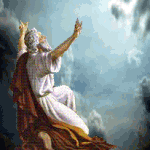The New Heaven and New Earth
 In this chapter, with the Devil, all demons and evil men gone, John is ushered into eternity and given a glimpse of the glorious new heaven and new earth God has prepared for His people beyond this age.
In this chapter, with the Devil, all demons and evil men gone, John is ushered into eternity and given a glimpse of the glorious new heaven and new earth God has prepared for His people beyond this age.
v.1 And I saw a new heaven and a new earth, for the first heaven and the first earth had passed away. Also there was no more sea.
The word “new” means “new in respect to freshness”, rather than “new with respect to existence.” In other words, what John sees is a “fresh heaven and fresh earth” that has undergone a cleansing and renewal and not one that has been totally annihilated and then recreated.
Peter describes the process as a virtual melt down of the very elements that make up the earth and heavens (2Pet.3:12); a fiery purging and cataclysmic renewal that produces new elements from the old elements.
“Yes, all of them will grow old like a garment, like a cloak You will change them, and they will be changed” (Ps.102:26)
As a result, every thumbprint, footprint, stain, and foul odor brought upon this present world by Satan, death, and sin will be sanitized. The blood, tears, bones, fossils, and grave sites that have long infected the earth’s surface, the defilement brought upon its core by the implant of Hades, and the pollution of contaminated materials and unholy sound and electronic impulses long thrust into its atmosphere will neither be found nor remembered again forever. (See also—Isa.65:17).
“Also there was no more sea.” Some commentators interpret this passage to mean the absence of a literal sea, but it might be figurative. The Bible generally uses the term “sea” and “waters” to symbolize Gentile nations, multitudes, tongues, and ethnic groups (Dan.7; Rev.13; Rev.14). Yes, it might suggest that the new earth will not have an ocean, but I believe it is figurative and take it to mean that there will be no more distinction between Jew and Gentile in the New World, and the divisive cross-hatching of borders, boundaries, cultures, languages, and national allegiances between men will be done away with.
v.2 Then I, John saw the holy city, New Jerusalem, coming down out of heaven from God, prepared as a bride adorned for her husband.
“New Jerusalem” is the eternal city and dwelling place of the saints “Whose builder and maker is God” (Heb.11:10). Every believer since Abraham is waiting to see it, so when John actually does see it, you can almost hear the exclamation of joy and excitement when he says “Then I, John saw the holy city”.
This is the city “prepared” by God in the heavens for His resurrected and raptured saints (see—Heb.11:16) and undoubtedly the inspiration when Jesus told His disciples, “I go to prepare a place for you” (John 14:2), and elsewhere where it is written “Eye has not seen, nor ear heard, nor have entered into the heart of man the things which God has prepared for those who love Him” (1Cor.2:9). It’s shown to John as radiant as a bride adorned for her husband because it personifies in virtue all of the saints residing therein.
Okay, but this needs further explanation.
When earlier we witnessed the marriage of the Lamb (Rev.19:9) the bride was the Church and the guests in attendance were all the rest of the redeemed. But New Jerusalem, the eternal city, is the home for all those who are saved: The saints of the pre-Abrahamic period, the saints in Israel before Christ, the saints among the Gentiles from Abraham to Christ, the saints of the Tribulation (including the remnant of Israel who are saved), and the saints of the Millennium.
In other words, whatever distinctions may exist between the saints through the ages, the one triune God will be in personal relationship with all the redeemed of all the ages. All will be in perfect fellowship with Him, united with Him, and He will dwell with them all as His blessed people in the Holy City forever.